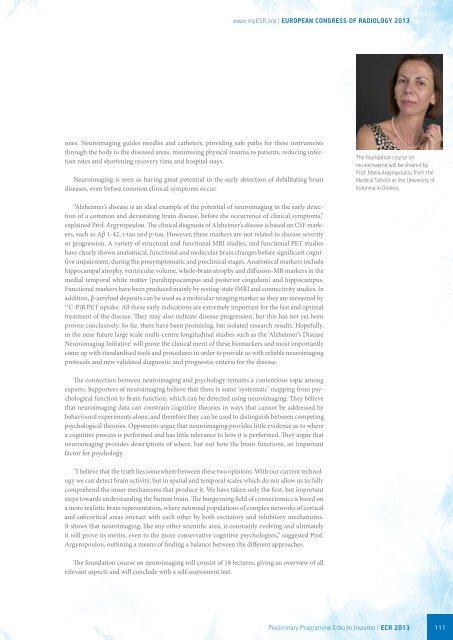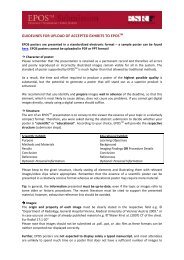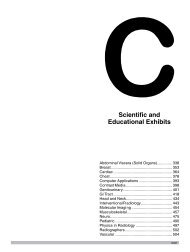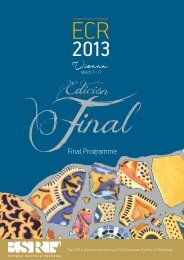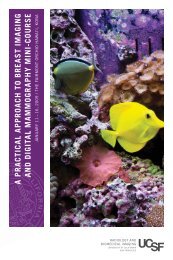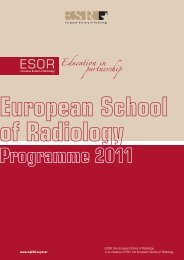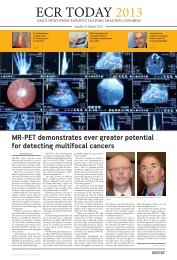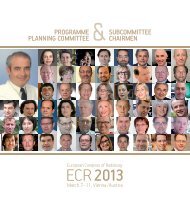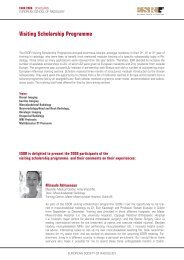New Horizons - myESR.org
New Horizons - myESR.org
New Horizons - myESR.org
- No tags were found...
You also want an ePaper? Increase the reach of your titles
YUMPU automatically turns print PDFs into web optimized ePapers that Google loves.
www.<strong>myESR</strong>.<strong>org</strong> | EUROPEAN CONGRESS OF RADIOLOGY 2013ones. Neuroimaging guides needles and catheters, providing safe paths for these instrumentsthrough the body to the diseased areas, minimising physical trauma to patients, reducing infectionrates and shortening recovery time and hospital stays.Neuroimaging is seen as having great potential in the early detection of debilitating braindiseases, even before common clinical symptoms occur.The foundation course onneuroimaging will be chaired byProf. Maria Argyropoulou from theMedical School at the University ofIoannina in Greece.“Alzheimer’s disease is an ideal example of the potential of neuroimaging in the early detectionof a common and devastating brain disease, before the occurrence of clinical symptoms,”explained Prof. Argyropoulou. The clinical diagnosis of Alzheimer’s disease is based on CSF markers,such as Aβ 1-42, t-tau and p-tau. However, these markers are not related to disease severityor progression. A variety of structural and functional MRI studies, and functional PET studieshave clearly shown anatomical, functional and molecular brain changes before significant cognitiveimpairment, during the presymptomatic and preclinical stages. Anatomical markers includehippocampal atrophy, ventricular volume, whole-brain atrophy and diffusion-MR markers in themedial temporal white matter (parahippocampus and posterior cingulum) and hippocampus.Functional markers have been produced mainly by resting-state fMRI and connectivity studies. Inaddition, β-amyloid deposits can be used as a molecular imaging marker as they are measured by11C-PiB PET uptake. All these early indications are extremely important for the fast and optimaltreatment of the disease. They may also indicate disease progression, but this has not yet beenproven conclusively. So far, there have been promising, but isolated research results. Hopefully,in the near future large scale multi-centre longitudinal studies such as the ‘Alzheimer’s DiseaseNeuroimaging Initiative’ will prove the clinical merit of these biomarkers and most importantlycome up with standardised tools and procedures in order to provide us with reliable neuroimagingprotocols and new validated diagnostic and prognostic criteria for the disease.The connection between neuroimaging and psychology remains a contentious topic amongexperts. Supporters of neuroimaging believe that there is some ‘systematic’ mapping from psychologicalfunction to brain function, which can be detected using neuroimaging. They believethat neuroimaging data can constrain cognitive theories in ways that cannot be addressed bybehavioural experiments alone, and therefore they can be used to distinguish between competingpsychological theories. Opponents argue that neuroimaging provides little evidence as to wherea cognitive process is performed and has little relevance to how it is performed. They argue thatneuroimaging provides descriptions of where, but not how the brain functions, an importantfactor for psychology.“I believe that the truth lies somewhere between these two opinions. With our current technologywe can detect brain activity, but in spatial and temporal scales which do not allow us to fullycomprehend the inner mechanisms that produce it. We have taken only the first, but importantsteps towards understanding the human brain. The burgeoning field of connectomics is based ona more realistic brain representation, where neuronal populations of complex networks of corticaland subcortical areas interact with each other by both excitatory and inhibitory mechanisms.It shows that neuroimaging, like any other scientific area, is constantly evolving and ultimatelyit will prove its merits, even to the more conservative cognitive psychologists,” suggested Prof.Argyropoulou, outlining a means of finding a balance between the different approaches.The foundation course on neuroimaging will consist of 18 lectures, giving an overview of allrelevant aspects and will conclude with a self-assessment test.Preliminary Programme EdiciÓn Invierno | ECR 2013111


